Naihanchi or Tekki Shodan is one of the oldest and most popular katas in karate. It’s also one of the most unusual.
Over the years, I’ve been told the techniques were designed for fighting in alleys, on boats, on horseback, working as a bodyguard, or—my personal favorite—defending yourself while standing on a rice paddy.
Hey—believe what you will!
The idea that makes the most sense to me, however, is that Naihanchi/Tekki Shodan was designed for ground fighting.
Specifically, when you’re stuck flat on your back. Think about it…
Falling or being knocked to the ground in a street fight is an age-old problem. Doesn’t it make sense that the old masters would have set aside a few special moves to deal with that situation?
In that spirit, here’s a video that explores the first four movements of Naihanchi/Tekki Shodan and explains how each can be utilized to defend yourself on the ground. If you’d like a summary of the bunkai in written form, you can find it below.
Now, hit the dirt!
Karate Ground Fighting:
Tekki Shodan Bunkai
Different styles and different teachers will obviously teach Naihanchi/Tekki Shodan in different ways. For me, any modification in timing or angle is acceptable so long as the form follows practical function.
In the case of the following ground fighting applications, I’m happy to say that most variations of Naihanchi or Tekki Shodan should match up with little trouble.
TECHNIQUE #1: STUFF THE HEAD
The main priority when an attacker is between your legs is not to wrap your legs around him and start wrestling… it’s to get back to your feet! That’s why the kata doesn’t cross the legs and “close the guard”.
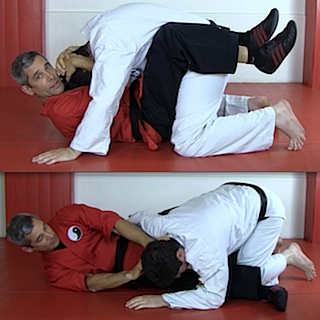
To stop the attacker from blasting you with punches, pinch your knees together to control his torso, then “bend your knees”. You’ll notice something interesting—
Bending your knees while lying on the ground brings the attacker down to you.
Once his balance is broken, catch his head and pull it to you. This will create your opportunity to escape.
Locking out your arms, press down against the top of his head and scoot backwards. When you have gained enough space, kick your attacker in the face and scramble to your feet.
Of course, the kata doesn’t include kicking and scrambling in its sequence. Otherwise, every single movement in every kata would be followed by running out the door!
I should point out that most versions of Tekki begin by touching the hands together in front of the waist. I prefer the opening movement of Naihanchi kata where the hands travel from high to low. And now you can see why…
The full motion symbolizes catching and stuffing the head.
TECHNIQUE #2: HOOK THE FOOT
The cross-step in Naihanchi/Tekki Shodan has always been a tricky movement to interpret. Is it a shuffle step? A kick? A trap? A sweep?
Sure. All of that. But for me, a popular ground technique fits even better.
The first time I saw this mount escape in a Brazilian Jiu Jitsu class, I yelled out, “That’s Naihanchi!” They all thought I was crazy. Regardless, it turned out I’ve been practicing this technique for years without even knowing it!
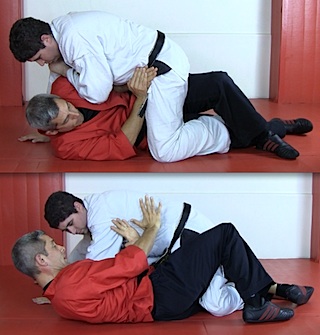
When an attacker is sitting on your belly, the kata tells you to first block one of his hips with your hands. Why? To prevent him from climbing higher up on your chest and making your situation worse.
You’ll notice another interesting feature of Naihanchi/Tekki Shodan at this point—
Low hand positions appear to be pressing down while standing, but on the ground, the hands are actually in front of you.
Posting your hands in front of your waist is used all the time in BJJ. To me, this is one of the biggest clues that Tekki was designed for ground fighting.
Now, why turn your head to a 45 degree angle? Because you need to turn to a 45 degree angle to set your legs into position for this escape.
But be careful—turn to 90 degrees and your attacker may jump on your back.
Once you’ve blocked the hip and turned to 45 degrees, the footwork for the escape matches the kata exactly…
Step your top leg over to hook the attacker’s foot. Pull the foot back as you slide your right leg around to the other side. Now pinch his leg.
By pinching your attacker’s leg with both of yours, you will control his hip and open up a path to kick away. Simple and effective.
So, don’t be fooled by that little cross-step… it contains one of the most powerful ways to escape one of the most dangerous positions in fighting.
— PLEASE NOTE! —
I’m not claiming that any of these ground fighting techniques would hold up against a world class BJJ champion. If someone is skilled on the ground, they will assuredly have counters for your counters.
These techniques are for crazies, not Gracies!
But Karate wasn’t designed to ward off Olympic wrestlers and BJJ champs. Karate was created to defend yourself against most people in most situations. So, have faith that these techniques will give you a fighting chance if the average punk takes you to the ground.
Uh—if you practice, that is! Okay—on to the next moves…
TECHNIQUE #3: PARRY AND POST
This technique can be used to defend against punches and elbows from a guard, mount, or side control position. Every martial artist should know it.
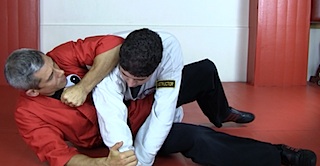
The crossing of the hands before you step out to the horse stance represents parrying and pulling an attacker’s arm to the ground. This instantly gives you the positional advantage of having both of your arms behind one of his.
With the attacker stretched over to the side, you can then use your elbow to strike behind the neck, jaw, or elbow. As you drive the attacker forward on a 45 degree angle, you are free to scoot back and kick yourself out.
You may be wondering why the kata steps out to a horse stance while extending the arm to the side. The answer is stability.
If you log roll on to your side with legs together, the attacker can easily pin your legs or keep you rolling on to your stomach. Spreading out your leg supports your body so that you can’t be easily turned.
Again, Naihanchi/Tekki Shodan provides a simple answer for a common problem on the ground.
TECHNIQUE #4: TURN THE HEAD
The fourth movement is an all-purpose technique whether you’re standing or on the ground—seizing the head. It should go without saying that any time you can grab your attacker’s head, a bad situation becomes much easier to improve.
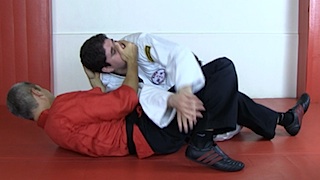
In this case, the stacking of fists on the hip—the “cup and saucer”—represents grabbing the head by the hair, chin, face, or whatever you like.
The placement of the head along your waist allows you to utilize the power of your core muscles to turn the head and move the attacker instead of merely using your arms.
You can use both hands to turn the head or break up the timing as encoded in the kata by throwing a “low block” and “cross-punch”. The “low block” can pull the attacker’s hair or face back while the cross-punch strikes into the neck or face. That’s up to you.
There you have it! The first four movements of Naihanchi/Tekki Shodan interpreted as ground fighting movements. You may now be asking, “Can the rest of the kata be applied to ground fighting, too?”
Absolutely! But don’t wait for me to show you how. Instead, do yourself a favor…
Grab a partner. Get on your back. Ask them to attack. Try to stop them!
I bet you’ll discover the same thing I did—Tekki Shodan was made for ground fighting!

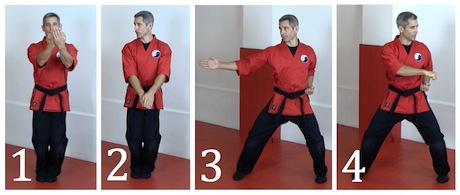
Ossu! [bow]
Totally geeking out here! Wow! I wonder if we have this kata in Shindo Jinen-ryu? I wonder if I can wait a few years to start learning these really advanced katas? 🙂 Hey, what would happen if my daughter and I did Pinan katas on our backs? At our lowly rank probably we’d only get a good laugh out of it 🙂 Thanks for this video – I absolutely love kata and bunkai!
[bow]
OSU!
Geek out, Jo! I say explore your moves every which way. After all, making personal connections and discoveries within the material is what puts the “art” into martial arts! 🙂
Wow that’s pretty cool. I’ve seen a lot of bunkai for naihanchi, but never thought to take it to the ground. I’m going to try that tonight at class! Great idea.
I’m honored that you’d give it a try, sir! Hope it works out. If it doesn’t, let me know!
I believe that tekki prepares a person to fight in diverse situations when one can`t move.
Those situations may be while riding a cycle or a car, while being sat on a chair of a bar, or, as you say, when one is on the floor.
Examples of attacks;
https://www.youtube.com/watch?v=ZID-JYNaWXI
http://www.complex.com/pop-culture/2014/11/woman-stabs-cab-driver-on-camera
Hi Luis!
Wow! Thanks for those video clips. I can’t believe you found two separate taxi cab attacks… they really do look like Tekki!
It sounds like we agree that kata is all ultimately about principles of movement. Those principles can then be applied in many different ways, which is probably why no one can agree on the one “true” meaning of anything!
Thank you for the comment, sir!